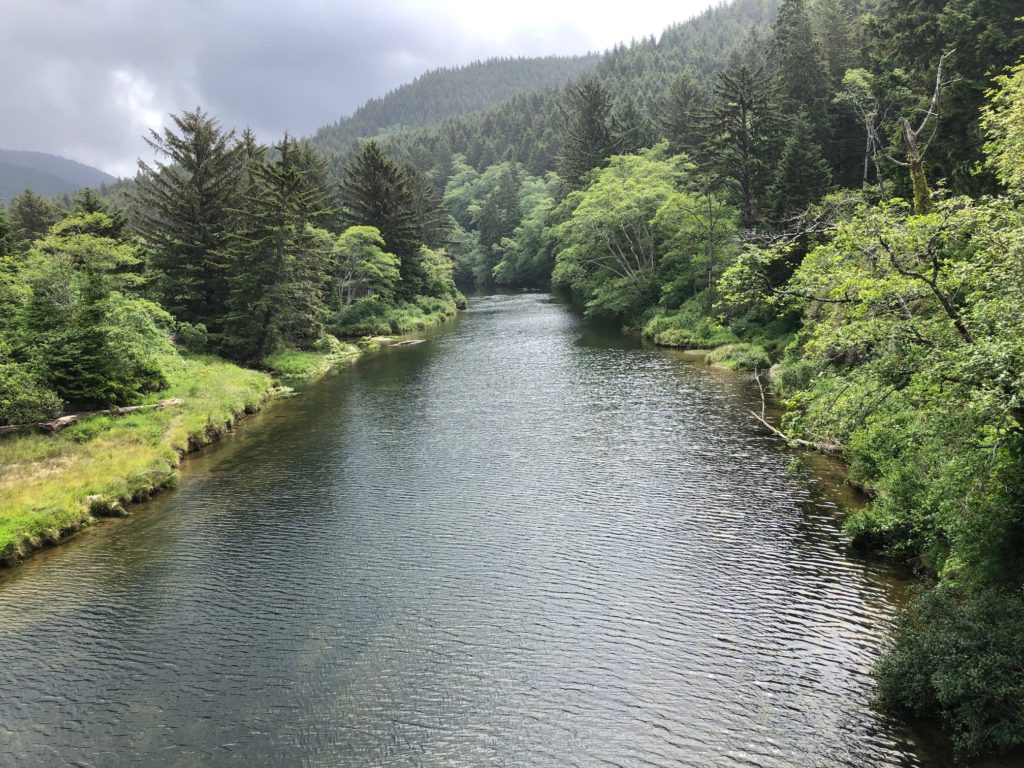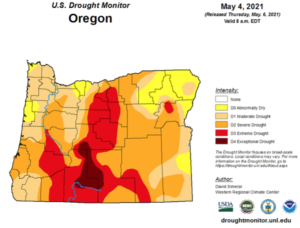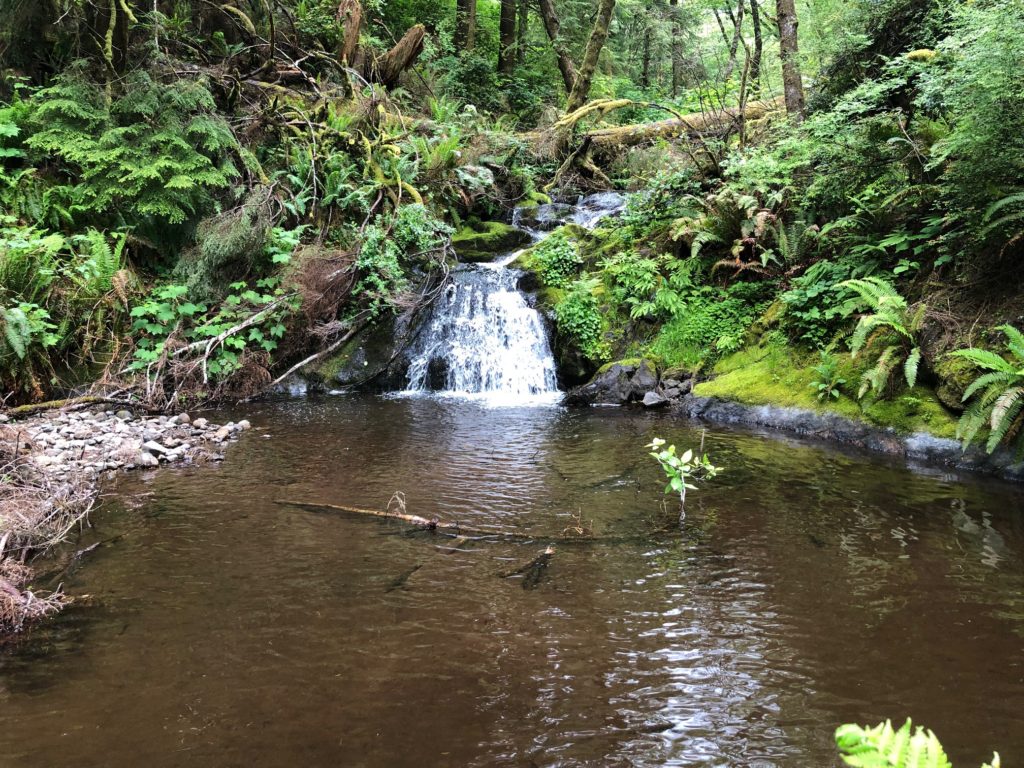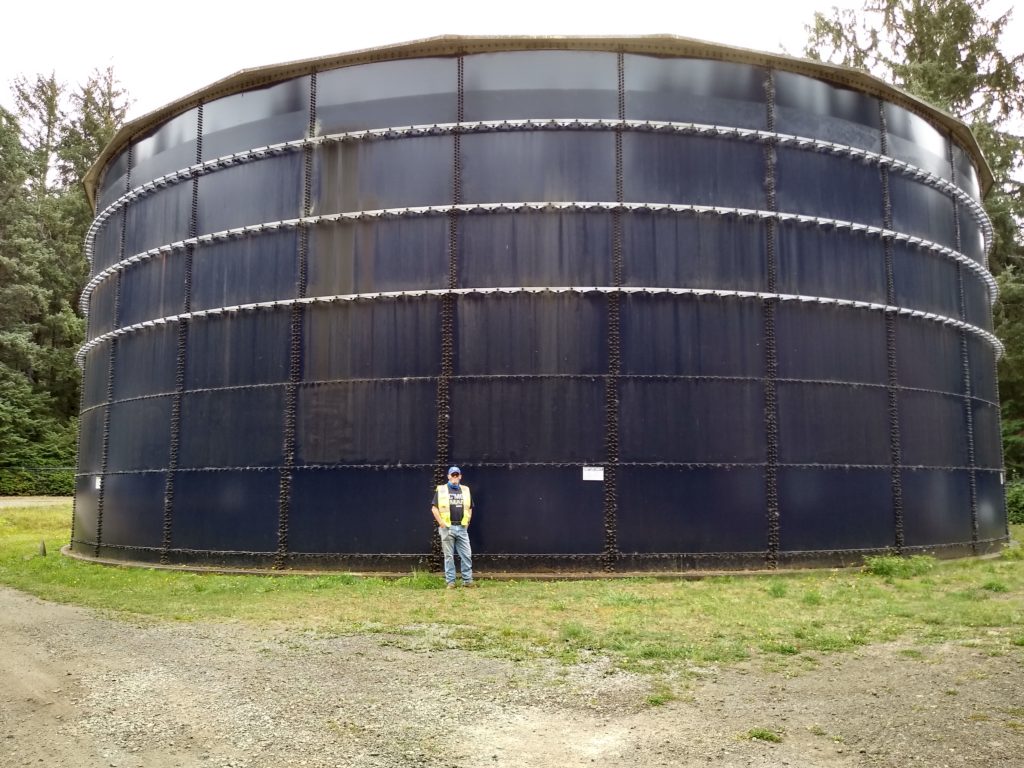
By QUINTON SMITH/YachatsNews.com
A two-week spell early this month with rain showers could help save – or delay – the implementation of water restrictions in Yachats.
Two-tenths of an inch of rain the first week of June – and the forecast for more the next seven days – is lessening the chance of water restrictions as early as mid-July.

“These rains are a blessing,” said Rick McClung, water plant supervisor for the city of Yachats. “If it rains for two weeks it should give us a three-week reprieve” on any later restrictions.
The second consecutive dry spring month in Yachats and Lincoln County has been fueling worries of scattered water shortages or restrictions this summer and the potential for another wave of wildfires even on the coast.
Rainfall measured by the city of Yachats so far this year is 76 percent of average. The National Weather Service’s summer forecast for Lincoln County shows the area is abnormally dry, with rainfall through April at 70 percent of normal – still better than most of Oregon, which is at 50 percent of normal.
The city recorded just 1.88 inches in May – the fourth lowest May total in the past 11 years. The May average is 3.11 inches. The dry May follows the driest April on record in Yachats and across much of Oregon.
So far this year 27.52 inches of rain has been measured by the city’s automatic gauge near the wastewater treatment plant. That compares to a five-month average of 36.14 inches.

Adam Altson, who has a manual gauge near the wastewater plant, measured 2.42 inches of rain in May, for a five-month total of 37.74 inches.
Donald Tucker, chair of the Southwest Lincoln County Water Public Utility District board, has been measuring rainfall at his house on the east side of U.S. Highway 101 two miles north of Yachats for 15 years. He recorded 2.09 inches of rain in May, and 33.51 so far in 2021.
Tucker’s May total was the sixth lowest in the past 15 years, reflecting an overall drying trend for the month.
A slightly better predictor of water availability for the city of Yachats’ use would be the rain gauge monitored by Jim Adler, a longtime water watcher who lives three miles up the Yachats River. His gauge is near Reedy Creek, the largest of two water sources for the city. Adler’s May total rainfall was 2.42 inches and 42.10 inches for the first five months of the year.
Adler’s total for May is the fourth lowest for the past 13 years he has been keeping records – and almost the same as in 2015, when the city of Yachats last instituted its most severe water restrictions.

Coastal creeks, rivers already low
Yachats gets its drinking water from Reedy and Salmon creeks. It can institute first phase of water restrictions when their total flow drops below 275 gallons per minute. Although the city does not pull water from the Yachats River, it uses its flow as another indicator and can institute restrictions when its flow drops below 35 cubic feet per second.
Adler said Yachats River flows were 38 cubic feet per second at the end of May, the lowest end-of-May totals since 2015 and 2016.
The city last had to restrict water use in September 2019 and August 2018.
The “Phase 1” rules restricts the watering of lawns, gardens and landscaping to alternate days depending on odd-even house addresses, allows the sale of water only to current customers, prohibits fire drills, hose and hydrant testing and truck washing by the Yachats Rural Fire Protection District, and prohibits use of water in ornamental fountains unless there is a recirculation system.
But McClung told the City Council last week that Phase 1 restrictions actually result in greater use because people become aware of the issue and begin to water their property more.
Yachats last instituted tighter Phase 2 water use restrictions in 2015. McClung said until this week’s rain, the water flow in Reedy and Salmon creeks this spring was 10 percent below their flow during the 2015 drought year.
Yachats’ water system has the capacity to produce 450,000 gallons of water a day. It has six storage tanks with a capacity of 1.7 million gallons.
During most June months, Yachats’ 850 residential and commercial customers use an average of 170,000 gallons of water a day, according to McClung. That peaks at 250,000 gallons a day over the July 4th holiday but remains high through August.

Help from neighbor to the north?
In Waldport, city manager Dann Cutter said while the city water sources are “fine right now” it will start pulling from its secondary water source — Eckman Creek — this week. That’s two months earlier than usual, he said.
“… at some point this summer we won’t be fine,” he said.
If that’s the case, the City Council could authorize some restrictions on water use – including limitations on watering lawns and landscaping, Cutter said.
The city gets its water mainly from the North and South forks of Weist Creek, with Eckman Creek as a additional, secondary source as needed. It decided to start pulling from Eckman this week to augment the low flow from the Weist system and keep its reservoirs full, Cutter said. The city has 1,400 water customers use an average of 189,000 gallons a day, Cutter said. It has two reservoirs with a capacity of 1.8 million gallons.
Last week, the Yachats City Council last week adopted a 20-year water master plan that outlines steps it should take to secure and improve its water system. One of the recommendations by Westech Engineering is to expand water capacity by building an intake in the upper Yachats River and piping water to the treatment plant farther downstream. It estimated that cost at $2.9 million.
But that is just a recommendation.
Councilor Greg Scott says a much less expensive idea could be to expand Yachats’ contract with the neighboring Southwest Lincoln County Water Public Utility District to simply buy water – if and when its needed – during the driest summer months.
Southwest Lincoln Water has much greater water sources and treatment capacity. The 75-year-old district serves 1,250 homes and businesses between Yachats and Waldport. It draws water from four creeks, has two plants that can treat 1.3 million gallons of water a day, and storage tanks that can hold 1.65 million gallons of treated water. Its customers’ average daily water use is 160,000 gallons, peaking to 400,000 gallons a day during the summer.

“We don’t anticipate any issues in regards to water supply this summer,” said SWLCPUD board chair Tucker, adding that its main treatment plant runs well below capacity.
Scott, Mayor Leslie Vaaler and Linn West, chair of the city’s Public Works & Streets Commission, hope to initiate meetings soon with SWLCPUD’s new manager and board.
The two systems are connected by a 6-inch pipe, allowing Southwest Lincoln to send water to Yachats during emergencies under a decades-old agreement.
Scott is interested in seeing if the city of Yachats can more simply become a customer when demand begins to exceed supply of its system.
Tucker told YachatsNews that the water district would welcome those conversations, adding that it had such a year-to-year supplemental agreement until 2018 when Yachats did not approach SWLCPUD about renewing it. He said the district has the capacity to help Yachats during the late summer or fall without affecting its own customers.
“That opportunity has been there for several years …” he said. “We’d be more than pleased to help the city … but we’d have to come to an agreement on the cost.”



I don’t understand water supply shortages when we have millions of gallons of fresh water flowing into the ocean every day. Why can’t some of the Yachats and Alsea rivers water be accumulated?